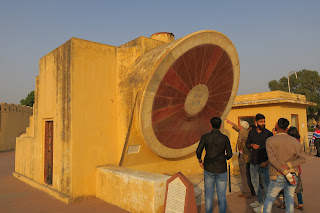A Jantar Mantar is an assembly of stone-built astronomical instruments, designed to be used with the naked eye.
There were five Jantar Mantars in India, all of them built at the command of the Rajah Jai Singh II, who had a keen interest in mathematics, architecture and astronomy.
The largest example is the equinoctial sundial belonging to Jaipur's assembly of instruments, consisting of a gigantic triangular gnomon with the hypotenuse parallel to the Earth's axis. On either side of the gnomon is a quadrant of a circle, parallel to the plane of the equator. The instrument can be used with an accuracy of about 2 seconds by a "skilled observer" to measure the time of day, and the declination of the Sun and the other heavenly bodies.
It is the world's largest stone sundial, known as the Vrihat Samrat Yantra. The Jaipur Jantar Mantar is a UNESCO World Heritage Site.
|
Laghu Samrat Yantra. |
|
Nadi Valaya Yantra. |
|
Jai Prakash Yantra. |
|
Rashi Valaya Yantra. |
|
Rama Yantra. |
|
Vrihat Samrat Yantra. |
See also
Source
Location




















